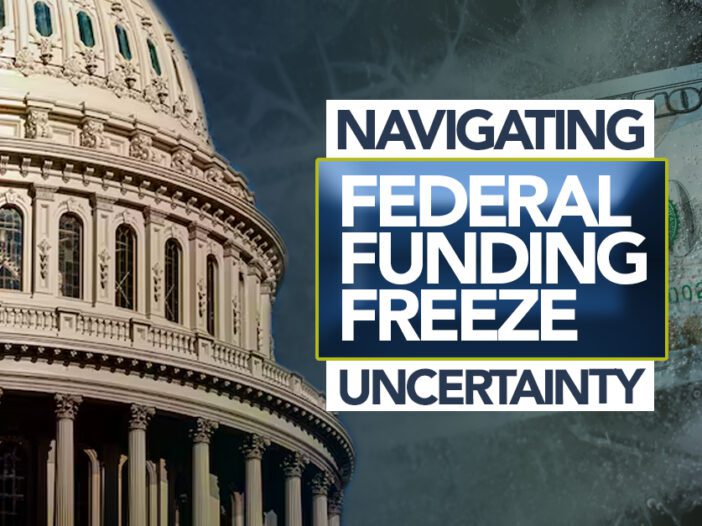
In an unprecedented move, the Office of Management and Budget (OMB) issued Memorandum M-25-13 on January 27, 2025, implementing a temporary pause across federal financial assistance programs. Although the memorandum was rescinded just two days later due to widespread confusion and legal challenges, the episode highlights the vulnerability of organizations reliant on federal funding. It also underscores the importance of preparation and agility in managing potential disruptions.
Here’s everything you need to know about the recent funding freeze, its implications, and actionable steps your organization can take to mitigate risks and remain resilient.
What Happened: A Timeline of Events
| January 27, 2025 | OMB issued Memorandum M-25-13, halting activities tied to federal financial assistance, including grants, loans, and other forms of funding. While essential programs like Medicare, Social Security, Medicaid, and SNAP were explicitly exempted, the scope of the freeze extended to many other programs, creating widespread uncertainty. |
| January 28, 2025 | OMB released an FAQ to clarify exempted programs, but confusion persisted. Federal grantees, including health centers and state agencies, reported issues such as blocked fund drawdowns and system access challenges. + A federal judge granted a temporary stay on the funding freeze, delaying its implementation until February 3. + A coalition of state attorneys general filed lawsuits opposing the memorandum. |
| January 29, 2025 | OMB issued Memorandum M-25-14, rescinding the original funding freeze. However, the administration continues to enforce executive orders (EOs) issued earlier in the year, which may still impact funding for specific programs. |
| Ongoing | Federal agencies are tasked with evaluating their programs’ alignment with executive orders, leaving lingering uncertainty for grantees. |
The Impact of the OMB Memo and Executive Orders
Why the Memo Created Chaos
The OMB memorandum broadly defined the funding freeze under 2 CFR 200.1, encompassing grants, loans, cooperative agreements, and more. While some programs were exempt, grantees faced immediate challenges:
- Funding disruptions for non-exempt programs, with agencies blocking drawdowns and reimbursements.
- Operational confusion due to unclear agency guidance on program reviews.
- System outages (e.g., Medicaid Payment Portal), adding to administrative bottlenecks.

Legal and Administrative Ramifications
Although Memorandum M-25-13 was rescinded, the administration’s executive orders remain in effect. These orders target programs tied to foreign aid, DEI initiatives, climate policy, and certain energy projects, causing some agencies to halt specific program activities even before the OMB memo.
For example:
- The Department of Energy instructed grantees to suspend activities related to DEI, Community Benefit Plans, and Justice40 initiatives.
- Similar directives may follow as agencies evaluate alignment with executive priorities.

Steps to Protect Your Organization
Facing potential funding freezes or disruptions requires proactive preparation. Below are key strategies your organization can adopt:
1. Review Federal Grants and Funding Agreements
- Understand contract terms: Pay close attention to clauses related to funding availability, drawdowns, and reimbursements.
- Know your funding streams: Identify which programs, grants, or loans are tied to executive orders and assess their vulnerability to future freezes.
2. Engage with Funding Agencies
Build open lines of communication with your funders. Ask:
- What steps is your agency taking to align with recent executive orders?
- Are there specific risks to our funding programs? What should we prepare for?
- How and when will changes be communicated?
3. Advocate for Federal Support
Don’t underestimate the power of advocacy in navigating federal funding uncertainty. Contacting your U.S. senators and representatives can help bring attention to the challenges your organization faces and potentially influence agency decisions or executive actions.
How to Advocate Effectively:
- Share your story: Explain how your organization serves the community and the potential impact of funding disruptions on critical services.
- Provide clear data: Include specific funding amounts, the number of people served, and the consequences of delays or interruptions.
- Request action: Ask legislators to intercede on behalf of your organization by contacting federal agencies, advocating for clarification or exemptions, or proposing legislative solutions.
- Engaging your elected officials can amplify your concerns and contribute to broader policy discussions surrounding federal funding priorities.
4. Conduct a Funding Risk Assessment
Use this opportunity to evaluate your financial exposure:
- Identify programs that might be at risk based on previous disruptions or alignment with federal priorities.
- Assess the potential short- and long-term financial impacts of paused or terminated funding.
5. Secure Cash Flow
- Submit drawdowns early: If your grant allows advance payments, request funds as soon as possible to avoid delays. Review 2 CFR 200.305 for rules on advance or reimbursement structures.
- Build a cash flow model: Create a flexible, daily model to account for different disruption scenarios.
- Review liquidity options: Identify available reserves, investments, or lines of credit to bridge funding gaps.
6. Develop a Contingency Plan
Prepare for possible funding disruptions in the future:
- Work with HR to evaluate workforce management strategies, such as program adjustments, paid/unpaid leave, and restructuring in case of prolonged funding loss.
- Use lessons learned from this situation to refine organizational policies and response plans.
7. Stay Informed
Monitor policy updates from federal agencies and legal developments surrounding executive orders.
Attend webinars, such as those provided by legal and accounting professionals, to better understand the evolving funding landscape.

A Time for Reflection and Resilience
The federal funding freeze, though short-lived, highlights the fragility of organizations dependent on government support. Whether your funding comes from federal, state, or local sources, preparation is key to weathering future disruptions.
Looking Forward
As new executive orders and federal priorities emerge, organizations will likely face continued uncertainty.
By taking proactive steps now, your organization can build resilience and be better prepared for future challenges in the federal funding landscape.






